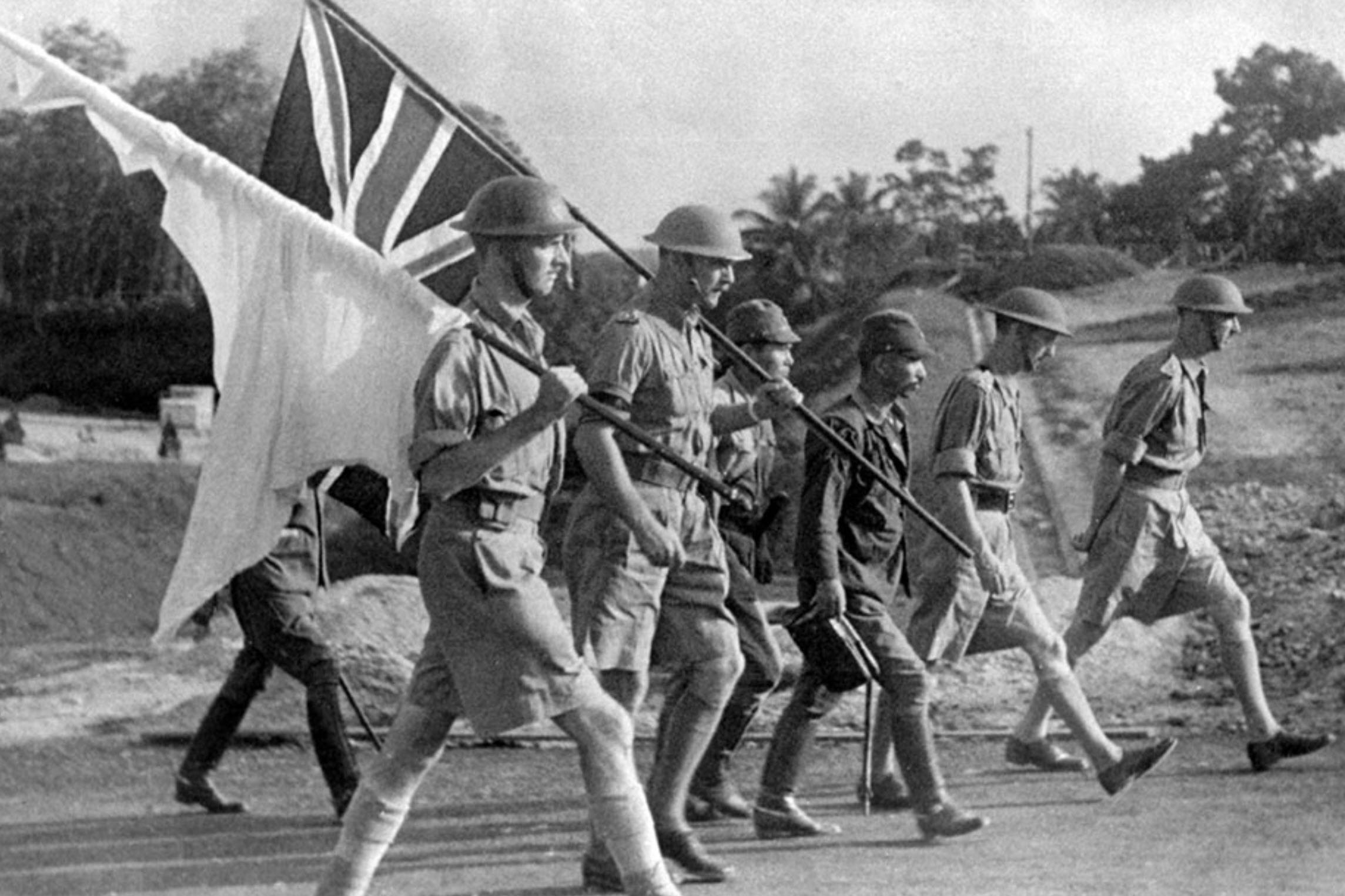Lieutenant-General Arthur Percival General Officer Commanding, Malaya 1941-1942
Allied Surrender Party walking up the hill at the Ford Factory
This blog is a shortened version. Please click on full version (in ‘pdf’ format) for the entire blog.
Lieutenant-General Arthur Percival
With a distinguished military career to date, in 1936, Percival was promoted to colonel and was appointed the General Staff Officer to Major-General William Dobbie who was the General Officer Commanding (GOC) Malaya. It was during this time that Percival carried out a tactical assessment of the vulnerability of Singapore. He identified the possibility that Japanese forces would land on the east coast of Thailand and Malaya to capture aerodromes and thereby achieve air superiority. This report was sent to the War Office in London but it was largely ignored.
In March 1938, having been promoted to brigadier, he returned to England and by 1940 was a major-general and Assistant Chief of the Imperial General Staff at the War Office in London. In April 1941, with a promotion to lieutenant-general, Percival was appointed GOC Malaya. He noted that “In going to Malaya, there is the double danger of being left in an inactive command if war did not break out in the East, or finding myself involved in a sticky business with inadequate forces which are usually to be found in the distant parts of our Empire”.
On his arrival in Singapore, he discovered that the airstrips on the Malay Peninsula had not been placed in defensible positions, there was not a single tank as all 350 had been sent to Russia and the troops, particularly the Indians, were poorly trained. Furthermore, most equipment was either in short supply, obsolete or both (London considered that the war in North Africa was a higher priority for new equipment than Singapore). Percival intensified the training of the soldiers and attempted to construct defensive positions in the north of Malaya. But local British interest stepped in not wanting troops near their plantations or property. He devised a plan (Operation Matador) to seize a potential Japanese troop staging area in Thailand. This too was cancelled by Percival’s superior, Air Chief Marshall Brooke-Popham citing that it was the government’s policy to refrain from any acts that may be viewed as provocation.
Recreation of the last Command Conference on the 15th February 1942, at the Battlebox (Percival standing centre)
Not helping was Percival’s rocky relationship with his two senior generals, Lieutenant-General Lewis Heath, the commander of the 3rd Indian Corps, and Major-General Gordon Bennett, the commander of the Australian 8th Division. Bennett.
The Japanese invaded Malaya on the 8th December 1941 in a manner almost as predicted by Percival some four years earlier. The British strategy was always a defensive one. By this time General Archibald Wavell had been appointed to take over from Brooke-Popham, Percival’s superior. Immediately, Wavell found that he was not happy with Percival’s performance. After the allied troops had been withdrawn to Singapore, Wavell and Percival clashed over the likely invasion point by the Japanese. Wavell was convinced that it would come from the north-west, whereas Percival insisted it would come from the north-east. Wavell gave in to Percival stating that there were sufficient troops on Singapore should the invasion come from either direction. On the 8th February 1942, the Japanese invaded from the north-west. But Percival insisted it was only a diversion and held back from sending in reinforcements. It wasn’t until nearly two days later when it was obvious that there would be no invasion from the north-east that the forces held in reserve, were added to the defence of Singapore. But it was too late. The Japanese had a strong hold on Singapore.
Yamashita (arms folded) discusses the allied surrender with Percival (second from left at front)
By the 14th February, the Japanese were approaching the city limits of Singapore. They had captured the ammunition stores and the water supply. On the morning of the 15th, Percival held his final command conference. He was informed that both water and ammunition would run out by the following day. Percival agreed to surrender and late that afternoon, under a white flag, he and his surrender party marched up the hill to the Ford Motor Factory at Bukit Timah, to meet with Japanese Lieutenant-General Tomoyuki Yamashita, the commander of the Japanese forces. Although the Japanese themselves were running short of ammunition, Yamashita bluffed Percival into surrendering unconditionally. Over 100,000 allied soldiers including about 14,000 Australians became prisoners of war of the Japanese.
After the surrender, Percival was held in Changi Prison and in August 1942, was sent to Manchuria where he stayed until the end of the war. US General Douglas MacArthur invited Percival to attend the Japanese surrender ceremony on the USS Missouri in Tokyo Bay. Percival also attended the Japanese surrender ceremony in the Philippines where he met Yamashita one last time. Whether shunned or not by the British, Percival did not attend the British-led Japanese surrender ceremony in Singapore.
US General Douglas MacArthur hands Lieutenant-General Percival one of the pens used at the Japanese surrender on the USS Missouri
Percival returned to England in September 1946 and later that year, retired from the army. He found himself ridiculed for his leadership in Malaya but was respected for his time spent as a prisoner of war. Percival died in January 1966, at the age of 78.
During WW1 and the years shortly after, as a leader, Percival was courageous and tenacious in the face of the enemy. Attributes that he did not seem to show when GOC Malaya. It is clear that Percival made a number of tactical blunders in the defence of Singapore But, was it the case, given Singapore’s years of neglect by the British government and the military establishment in London (of which Percival had been part), that Singapore would always fall?





